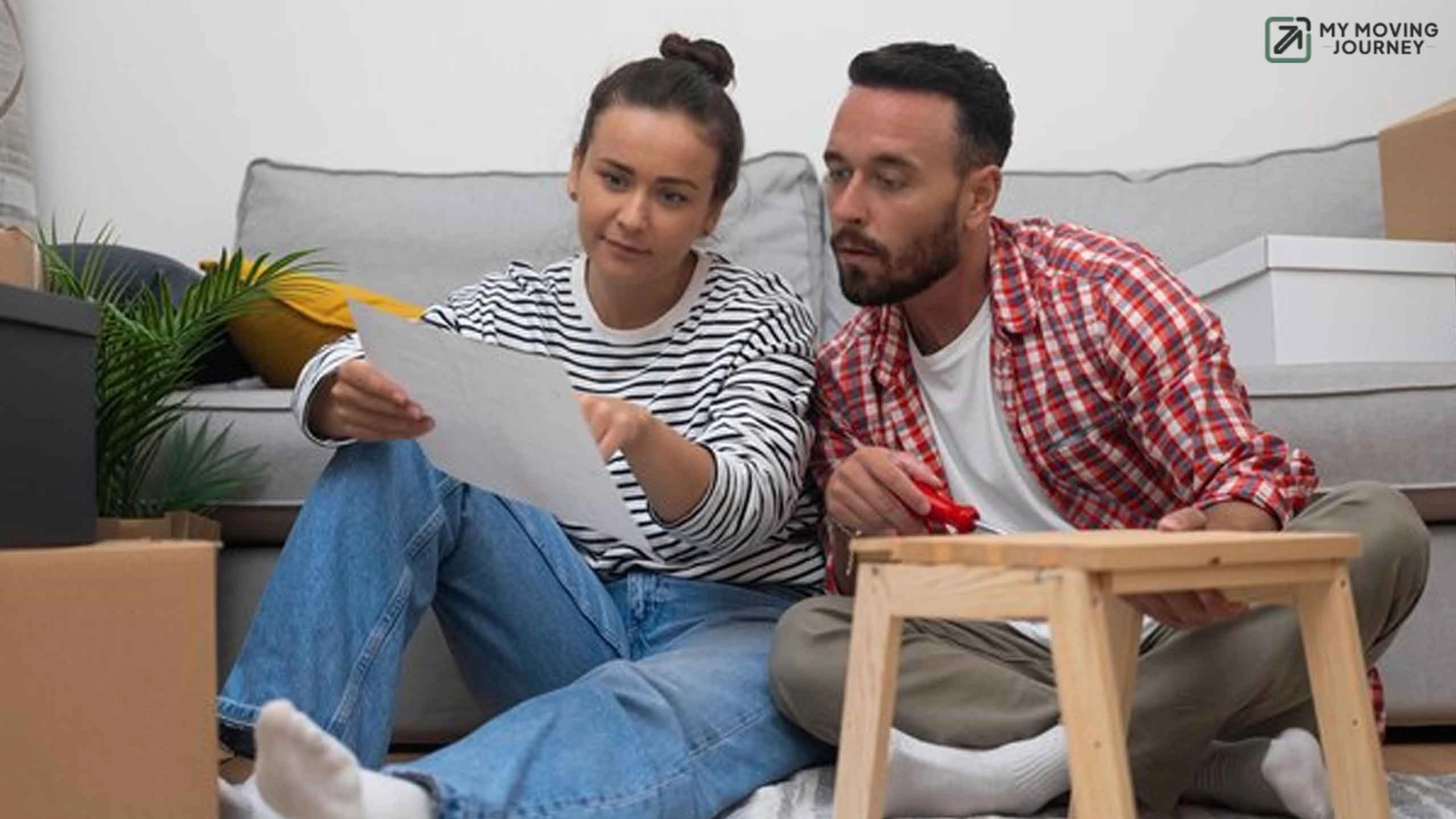Home is the starting place of love, hope, and dreams. This famous saying perfectly captures the excitement of moving into a new house—a fresh space to build memories, set goals, and make it truly your own. But as anyone who's gone through the moving process will tell you, the journey to creating that dream home can be overwhelming.
Did you know that the average American moves about 11 times in their lifetime? That's a lot of packing, organizing, and settling into new spaces!
Whether you're making your first big move or you're a seasoned mover, the logistics involved can be stressful. And it's not just the hassle of moving boxes—there's the financial hit, too.
In fact, according to a recent survey, new homeowners in the U.S. spend an average of $10,601 in the first year on additional expenses like furniture, appliances, and repairs.
But with the right preparation, moving can be an enjoyable experience, too. Let’s discuss some practical tips for moving into a new house that will help you stay organized, save money, and settle in smoothly.
After this, you can easily identify the things you need when moving into a new house and even draft the perfect checklist for moving into a new house.
Before You Move: Get Organized
1. Declutter and Donate
The first step in any move is to declutter. Go through each room and decide what to keep, donate, or toss. The less you have to pack, the easier your move will be.
Selling or donating items can also reduce moving costs. However, some professional movers will not transport certain items, so it's best to check ahead.
2. Set a Moving Budget
Moving isn’t cheap. From hiring movers to packing supplies, the expenses can add up. Setting a budget is crucial. Be sure to factor in costs like temporary housing, storage units, and unexpected fees. If you're hiring movers, get quotes from at least three companies.
3. Change of Address
Submit your change of address with USPS and notify banks, subscriptions, and any other services that send you mail. Make sure your employer, family, and friends know, too.
4. Compare Utility Costs
Utilities can vary significantly from your current location. Research utility rates in your new neighborhood—things like water, gas, trash pickup, and internet may be different from what you're used to. This will help you update your budget accordingly.
Packing Essentials: What You’ll Need
Packing takes most of your moving time, but knowing the essential items for a new home can simplify the process. Don’t wait until moving day to get your packing supplies in order.
1. Pack a First-Night Box
One of the most important things to have when moving into a house is a "first-night" box. This should include essentials like toiletries, basic kitchen items, chargers, clothes, and medications. You'll appreciate having these items readily available when you're too tired to unpack.
2. Label Your Boxes Clearly
Proper labeling is a game-changer. Mark your boxes with the room they belong in and add descriptions of what's inside. This makes unpacking much easier and ensures crucial items aren't lost in the shuffle.
Moving Day: Key Tips
1. Hire Professional Cleaners
Even if the previous owners cleaned the house, a professional deep clean ensures your new home is sparkling and germ-free. It's much easier to get everything cleaned before the movers arrive.
2. Check Utilities
Ensure that all utilities—water, electricity, gas, and internet—are set up before you arrive. It's incredibly frustrating to spend your first night in the dark or without running water.
3. Inspect Your Home for Safety
Check all smoke and carbon monoxide detectors and locks on doors and windows. Replace the batteries in alarms and consider installing a security system if one isn't already in place.
How Can a Moving Checklist Help You Prepare for Your Move?
A moving checklist is like your roadmap to a stress-free move. Think about it: you're juggling dozens of tasks, from changing your address to figuring out what to pack first. Without a plan, it’s easy to forget something important. But how exactly does a checklist make a difference? Let’s break it down in detail:
1. Keeps You Organized and On Schedule
Moving into a new house can feel chaotic. There's packing, scheduling movers, transferring utilities, and a thousand small things to handle. A well-crafted checklist organizes these tasks into manageable chunks. You'll know exactly what needs to be done and when, so you're not left scrambling at the last minute.

45% of Americans say they find moving to be more stressful than any other major life event, including divorce?
2. Helps You Budget and Avoid Unnecessary Costs
Moving isn’t cheap, and expenses can add up quickly. With a checklist, you can plan ahead and allocate funds for each part of your move, from hiring professional movers to purchasing packing supplies.

On average, a full-service move in the U.S. can cost between $4,000 and $10,000, depending on the distance and size of the move.
3. Prevents Overpacking and Overwhelm
A common issue when moving is packing too much or too little. A checklist can include reminders to declutter ahead of time, ensuring you only bring what’s essential to your new home.

According to the American Moving & Storage Association, about 37% of homeowners regret bringing so much stuff they never used.
4. You Don’t Forget Important Tasks
When you're dealing with the excitement and chaos of moving, it’s easy to overlook key details—like transferring utilities or scheduling the internet setup. A proper checklist ensures you remember these crucial tasks so you're not left without electricity or Wi-Fi on your first night in your new house.
5. Reduces Moving Stress for Families and Pets
A checklist can also include specific steps for making the transition easier for everyone involved.

Moving is one of the most significant stressors for both adults and children, with 61% of families reporting increased anxiety during the process.
For kids, a checklist can help you plan activities to keep them occupied and excited about their new space. For pets, you can ensure their essentials—like food, bedding, and toys—are packed separately so they can quickly settle in once you arrive.
7. Makes Unpacking Easier
A good checklist doesn’t stop at the moving process—it extends into unpacking, too. By labeling boxes properly and ensuring everything has a place, your checklist can guide you through an organized unpacking process, room by room.
How to Set Up Your New Home
You’re eager to start fresh, but with so many boxes and tasks, where do you begin? Don’t worry—let’s break it down step by step and guide you through the process.
1. Start with Safety First
Before anything else, you want to ensure your home is safe and secure. This includes checking all smoke detectors, carbon monoxide alarms, and locks. For peace of mind, you can replace alarm batteries and change out locks. Consider installing a security system, especially if you are moving into an unfamiliar neighborhood.

Many experts recommend that homeowners set aside 1% of their home’s purchase price each year for maintenance and repairs.
2. Unpack Your Essentials First
The first thing to do is to unpack what you need immediately. Think of the essential items for a new home: kitchen supplies, bathroom toiletries, and bed linens. You don’t need to tackle everything on day one, but you should have the basics covered to live comfortably.
A first-night box comes in handy here, including items like your phone charger, pajamas, toothbrush, and maybe a pot for boiling water or a coffeemaker for your much-needed morning coffee.

According to surveys, around 28% of people forget to pack these crucial items. Don’t make that mistake—get those essentials sorted right away!
3. Organize Your Kitchen and Bedrooms
Once you’ve got your essentials unpacked, it’s time to prioritize rooms. It is always recommended to start with the kitchen and bedrooms.
Why? The kitchen is the heart of the home—you'll need it to prepare meals and energize yourself during those long unpacking days. Organize your pantry, set up the fridge, and unpack your pots, pans, and dishes.
4. Set Up Utilities and Wi-Fi
Let's be honest: In today's world, one of the first things you'll want to get sorted is your internet connection. Make sure to schedule the installation or transfer of your Wi-Fi service before moving in so you're not left without access to work or entertainment.
5. Install Window Coverings and Lighting
If your new home doesn't have window coverings, this should be one of your next steps. Curtains or blinds offer privacy and help regulate the temperature of your home, keeping the space cooler in the summer and warmer in the winter.
Don't forget about lighting, either! Swapping out old lights or adding new lamps can instantly make your space more welcoming.
According to a survey, new homeowners often spend around $56 on curtains and drapes and more on light fixtures, according to one survey.
6. Set Up a Maintenance Plan
Your new house will need regular upkeep to stay in top shape. As a rule of thumb, most experts suggest setting aside 1-3% of your home’s value each year for maintenance costs.
How Much Does It Cost to Move into House
Moving into a new house is exciting, but it's also important to understand the costs involved.
DIY Move Costs
If you decide to go the DIY route, here are the main costs you might encounter:
| Cost Category | Details | Estimated Cost |
|---|---|---|
| Truck Rental | Renting a moving truck (size varies by need) | $20 - $150 per day |
| Gas | Fuel for the truck (based on distance) | $50 - $200 |
| Moving Supplies | Boxes, tape, bubble wrap, etc. | $100 - $300 |
| Insurance | Coverage for the truck and belongings | $10 - $50 |
| Helpers | Friends/family or hired labor for loading/unloading | $0 (friends) - $300 |
| Storage Fees | If you need temporary storage | $50 - $300 per month |
| Cleaning Supplies | For cleaning the old/new home | $20 - $50 |
| Food & Drinks | For you and your helpers during the move | $20 - $100 |
Total Estimated DIY Cost: $290 - $1,600 (depending on specifics)
Related Article:
Moving on a Budget: Tips for Saving Money
Professional Move Costs
If you’re considering hiring movers, the costs can vary significantly based on distance and the size of your move:
| Cost Category | Details | Estimated Cost |
|---|---|---|
| Moving Company Fee | Based on weight, distance, and time | $800 - $2,500+ |
| Packing Services | If you want professionals to pack your items | $200 - $1,000 |
| Insurance | Valuation coverage for your belongings | $100 - $500 |
| Storage Fees | If needed for interim storage | $50 - $300 per month |
| Additional Services | Unpacking, assembling furniture, etc. | $50 - $200 per hour |
| Tips for Movers | Generally, 10-20% of the total cost | $80 - $500 |
| Cleaning Services | Cleaning the old/new home before/after the move | $100 - $300 |
Total Estimated Professional Cost: $1,380 - $5,500+ (depending on specifics)
Additional Costs to Consider
Regardless of the moving method you choose, there are some additional expenses you might encounter:
| Cost Category | Details | Estimated Cost |
|---|---|---|
| Change of Address Fees | Updating your address with various services | Free - $50 |
| Utility Setup Fees | Deposits or installation fees for water, gas, electricity | $100 - $300 |
| Home Insurance | Adjusting or getting new home insurance | $50 - $150 |
| New Furniture/Items | If you need to buy new items for your new home | $200 - $1,000+ |
| Home Repairs | Any repairs needed before moving in | Varies |
Total Estimated Overall Cost
When you combine everything, your total moving costs could look like this:
- DIY Total: $290 - $1,600 + Additional Costs
- Professional Total: $1,380 - $5,500+ + Additional Costs




